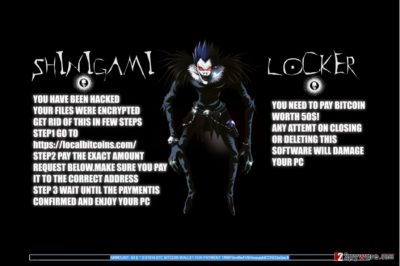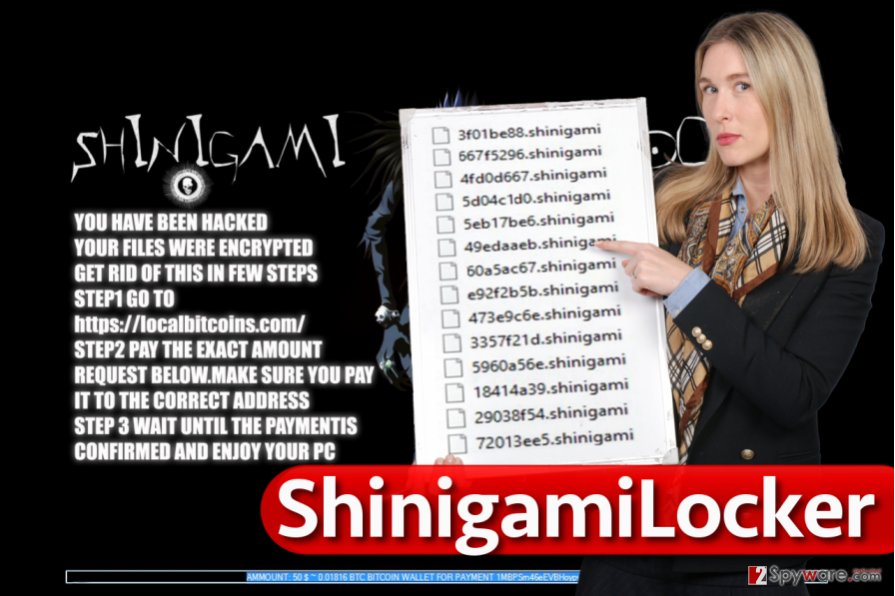ShinigamiLocker ransomware / virus (Improved Guide) - Free Guide
ShinigamiLocker virus Removal Guide
What is ShinigamiLocker ransomware virus?
ShinigamiLocker takes your files hostage for a Bitcoin ransom

ShinigamiLocker virus is a destructive computer program set to encrypt victim’s data with DES encryption algorithm[1]. The virus renames original file names with eight random characters and replaces the original extension with a .shinigami file extension. Consequently, the victim finds out that files can no longer be accessed.
ShinigamiLocker ransomware then changes the desktop wallpaper with a picture that says:
You have been hacked
Your files were encrypted
Get rid of this in few steps
[Instructions on how to buy Bitcoins and send them to a particular Bitcoin wallet]
You need to pay Bitcoin worth 50$!
Any attempt on closing or deleting this software will damage your PC
Shinigami virus is executed from rANSOM.exe file (version 1.0.0.0). This executable application aims to take victim’s files hostage (including photos, videos, documents, music, other important files) and then take advantage of victim’s situation to demand a ransom.
Clearly, people cannot afford to lose their files all of a sudden, not to mention that we keep important work documents or just precious memories on our smart devices. Ransomware is a virtual extortion tool[2] that takes these files away and asks to pay a ransom in exchange for the decryption key.
In this case, the virus demands 50 US dollars, which, if compared to sums asked by other viruses, is not that high. However, that is NOT a reason to pay it; criminals are hardly trustworthy, and they might never decrypt your files. Remove ShinigamiLocker using a tool like FortectIntego and consider trying one of the data recovery options suggested below.

NOTE. It is important to delete Shinigami malware professionally. Leaving some of its files on the system can result in serious problems such as data or private information loss. Even if you have downloaded an automatic spyware or malware removal tool, use the ShinigamiLocker removal guide presented below to prevent the virus from blocking the removal process.
Ransomware distribution explained
It is pretty clear that ransomware viruses are distributed in ways to infect computers without users’ knowledge. For this reason, they are mainly distributed using deceptive techniques that are closely related to spam, malvertising, exploit kits and phishing (according to Novirus.uk[3]).
Fraudsters find creative ways to deceive computer users; however, their most favorite ransomware distribution technique is malicious spam. All that they need to do is to create some email accounts and bypass spam filters. They are later used for spam campaigns that deliver certain messages with attachments to victims.
If you want to be protected from ransomware, we highly suggest that you invest in a good computer security software and avoid clicking on suspicious links online. Even better, question everything! If you encountered some content online that seems suspicious, do not rush to explore it or you might have to face sad consequences.
Remove ShinigamiLocker for good
It is now time to remove ShinigamiLocker virus from your computer. Make sure that you have proper tools to complete this task. First of all, you will need to reboot your computer in a proper mode and delete the ransomware using anti-malware software then. For in-depth instructions on how to do it, please follow the instructions provided below.
After ShinigamiLocker removal, you can focus on data recovery. We have provided some options that might be helpful; however, you must remember that ransomware is a dangerous virus and it is not always possible to reverse the encryption process without having the decryption key.
Getting rid of ShinigamiLocker virus. Follow these steps
Manual removal using Safe Mode
If the virus corrupted your files, the first thing that you need to do is to remove ShinigamiLocker when in Safe Mode with Networking. Here is a short guide on how to do it.
Important! →
Manual removal guide might be too complicated for regular computer users. It requires advanced IT knowledge to be performed correctly (if vital system files are removed or damaged, it might result in full Windows compromise), and it also might take hours to complete. Therefore, we highly advise using the automatic method provided above instead.
Step 1. Access Safe Mode with Networking
Manual malware removal should be best performed in the Safe Mode environment.
Windows 7 / Vista / XP
- Click Start > Shutdown > Restart > OK.
- When your computer becomes active, start pressing F8 button (if that does not work, try F2, F12, Del, etc. – it all depends on your motherboard model) multiple times until you see the Advanced Boot Options window.
- Select Safe Mode with Networking from the list.

Windows 10 / Windows 8
- Right-click on Start button and select Settings.

- Scroll down to pick Update & Security.

- On the left side of the window, pick Recovery.
- Now scroll down to find Advanced Startup section.
- Click Restart now.

- Select Troubleshoot.

- Go to Advanced options.

- Select Startup Settings.

- Press Restart.
- Now press 5 or click 5) Enable Safe Mode with Networking.

Step 2. Shut down suspicious processes
Windows Task Manager is a useful tool that shows all the processes running in the background. If malware is running a process, you need to shut it down:
- Press Ctrl + Shift + Esc on your keyboard to open Windows Task Manager.
- Click on More details.

- Scroll down to Background processes section, and look for anything suspicious.
- Right-click and select Open file location.

- Go back to the process, right-click and pick End Task.

- Delete the contents of the malicious folder.
Step 3. Check program Startup
- Press Ctrl + Shift + Esc on your keyboard to open Windows Task Manager.
- Go to Startup tab.
- Right-click on the suspicious program and pick Disable.

Step 4. Delete virus files
Malware-related files can be found in various places within your computer. Here are instructions that could help you find them:
- Type in Disk Cleanup in Windows search and press Enter.

- Select the drive you want to clean (C: is your main drive by default and is likely to be the one that has malicious files in).
- Scroll through the Files to delete list and select the following:
Temporary Internet Files
Downloads
Recycle Bin
Temporary files - Pick Clean up system files.

- You can also look for other malicious files hidden in the following folders (type these entries in Windows Search and press Enter):
%AppData%
%LocalAppData%
%ProgramData%
%WinDir%
After you are finished, reboot the PC in normal mode.
Remove ShinigamiLocker using System Restore
-
Step 1: Reboot your computer to Safe Mode with Command Prompt
Windows 7 / Vista / XP- Click Start → Shutdown → Restart → OK.
- When your computer becomes active, start pressing F8 multiple times until you see the Advanced Boot Options window.
-
Select Command Prompt from the list

Windows 10 / Windows 8- Press the Power button at the Windows login screen. Now press and hold Shift, which is on your keyboard, and click Restart..
- Now select Troubleshoot → Advanced options → Startup Settings and finally press Restart.
-
Once your computer becomes active, select Enable Safe Mode with Command Prompt in Startup Settings window.

-
Step 2: Restore your system files and settings
-
Once the Command Prompt window shows up, enter cd restore and click Enter.

-
Now type rstrui.exe and press Enter again..

-
When a new window shows up, click Next and select your restore point that is prior the infiltration of ShinigamiLocker. After doing that, click Next.


-
Now click Yes to start system restore.

-
Once the Command Prompt window shows up, enter cd restore and click Enter.
Bonus: Recover your data
Guide which is presented above is supposed to help you remove ShinigamiLocker from your computer. To recover your encrypted files, we recommend using a detailed guide prepared by 2-spyware.com security experts.Data recovery options are provided below. Please follow them carefully if you do not have a data backup. If you do, make sure that the virus has been removed by your security program and plug the data storage device into your computer.
If your files are encrypted by ShinigamiLocker, you can use several methods to restore them:
Data Recovery Pro tricks
If your files were corrupted, you can try this tool called Data Recovery Pro to restore your files. This tutorial explains how to start the tool and use it for data recovery. Please remember that it might not succeed in recovering files encrypted by ransomware.
- Download Data Recovery Pro;
- Follow the steps of Data Recovery Setup and install the program on your computer;
- Launch it and scan your computer for files encrypted by ShinigamiLocker ransomware;
- Restore them.
Data decryption tool for .Shinigami file extension files wasn't discovered yet
Finally, you should always think about the protection of crypto-ransomwares. In order to protect your computer from ShinigamiLocker and other ransomwares, use a reputable anti-spyware, such as FortectIntego, SpyHunter 5Combo Cleaner or Malwarebytes
How to prevent from getting ransomware
Access your website securely from any location
When you work on the domain, site, blog, or different project that requires constant management, content creation, or coding, you may need to connect to the server and content management service more often. The best solution for creating a tighter network could be a dedicated/fixed IP address.
If you make your IP address static and set to your device, you can connect to the CMS from any location and do not create any additional issues for the server or network manager that needs to monitor connections and activities. VPN software providers like Private Internet Access can help you with such settings and offer the option to control the online reputation and manage projects easily from any part of the world.
Recover files after data-affecting malware attacks
While much of the data can be accidentally deleted due to various reasons, malware is one of the main culprits that can cause loss of pictures, documents, videos, and other important files. More serious malware infections lead to significant data loss when your documents, system files, and images get encrypted. In particular, ransomware is is a type of malware that focuses on such functions, so your files become useless without an ability to access them.
Even though there is little to no possibility to recover after file-locking threats, some applications have features for data recovery in the system. In some cases, Data Recovery Pro can also help to recover at least some portion of your data after data-locking virus infection or general cyber infection.
- ^ Data Encryption Standard. TutorialsPoint - Cryptography. The Basics of the Science of Cryptography.
- ^ Ransomware: the Tool of Choice for Cyber Extortion. FireEye. Resources.
- ^ NoVirus. NoVirus. Malware Removal Guides, Cyber Security News.





















